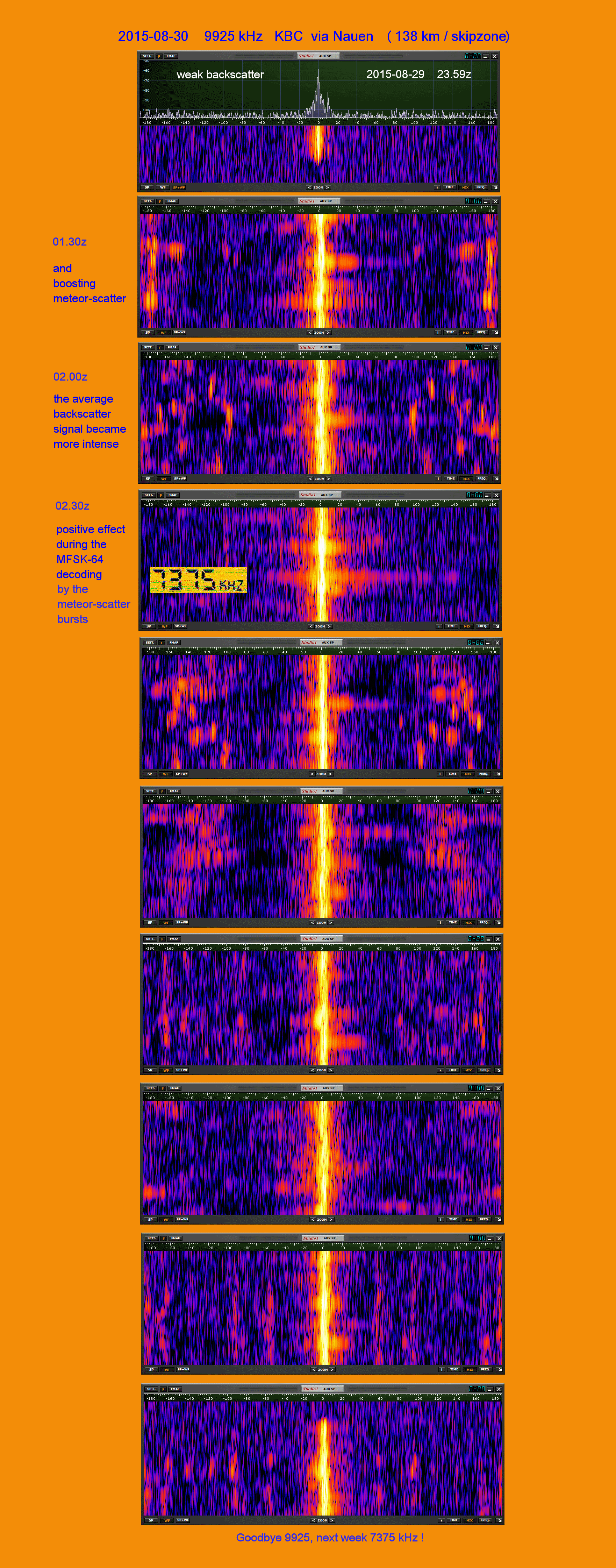
www.rhci-online.net/radiogram/radiogram.htm
██╗ ██╗██████╗ ██████╗ ██████╗ █████╗ ██████╗ ██╗ ██████╗ ██████╗ ██████╗ █████╗ ███╗ ███╗ ██║ ██╔╝██╔══██╗██╔════╝ ██╔══██╗██╔══██╗██╔══██╗██║██╔═══██╗██╔════╝ ██╔══██╗██╔══██╗████╗ ████║ █████╔╝ ██████╔╝██║ ██████╔╝███████║██║ ██║██║██║ ██║██║ ███╗██████╔╝███████║██╔████╔██║ ██╔═██╗ ██╔══██╗██║ ██╔══██╗██╔══██║██║ ██║██║██║ ██║██║ ██║██╔══██╗██╔══██║██║╚██╔╝██║ ██║ ██╗██████╔╝╚██████╗ ██║ ██║██║ ██║██████╔╝██║╚██████╔╝╚██████╔╝██║ ██║██║ ██║██║ ╚═╝ ██║ ╚═╝ ╚═╝╚═════╝ ╚═════╝ ╚═╝ ╚═╝╚═╝ ╚═╝╚═════╝ ╚═╝ ╚═════╝ ╚═════╝ ╚═╝ ╚═╝╚═╝ ╚═╝╚═╝ ╚═╝
|

RSID: <<2015-08-30T02:30Z
MFSK-64 @
9925000+1500>>
Judging from reception lately on 9925 kHz, next weekend's KBC
frequency change to 7375 kHz is just in time ...
|
Sending Pic:277x73C; |
studio recording |
|
|
|

██╗ ██╗ ██████╗ █████╗ ██████╗ █████╗ ██████╗ ██╗ ██████╗ ██████╗ ██████╗ █████╗ ███╗ ███╗ ██║ ██║██╔═══██╗██╔══██╗ ██╔══██╗██╔══██╗██╔══██╗██║██╔═══██╗██╔════╝ ██╔══██╗██╔══██╗████╗ ████║ ██║ ██║██║ ██║███████║ ██████╔╝███████║██║ ██║██║██║ ██║██║ ███╗██████╔╝███████║██╔████╔██║ ╚██╗ ██╔╝██║ ██║██╔══██║ ██╔══██╗██╔══██║██║ ██║██║██║ ██║██║ ██║██╔══██╗██╔══██║██║╚██╔╝██║ ╚████╔╝ ╚██████╔╝██║ ██║ ██║ ██║██║ ██║██████╔╝██║╚██████╔╝╚██████╔╝██║ ██║██║ ██║██║ ╚═╝ ██║ ╚═══╝ ╚═════╝ ╚═╝ ╚═╝ ╚═╝ ╚═╝╚═╝ ╚═╝╚═════╝ ╚═╝ ╚═════╝ ╚═════╝ ╚═╝ ╚═╝╚═╝ ╚═╝╚═╝ ╚═╝
RSID: <<2015-08-29T16:01Z
MFSK-32 @ 17870000+1500>>
Welcome to program 126 of VOA Radiogram from the Voice of
America.
I'm Kim Andrew Elliott in Washington.
Here is the lineup for today's program, all in MFSK32 except
where noted:
1:30 Program preview (now)
2:45 Strife reduces pollution in parts of Middle East*
9:03 Diminished marine biodiversity*
16:10 Plastic debris in the Pacific Ocean*
24:18 MFSK32 at 2000 Hz: Same image*
26:37 MFSK32 at 1500 Hz: Closing announcements*
28:23 Olivia 64-2000: Transmission schedule
* with image
Please send reception reports to radiogram@voanews.com.
And visit voaradiogram.net.
Twitter: @VOARadiogram
VOA NEWS
Reduced Air Pollution in Mideast Tied to Strife, Economic Decline
Jessica Berman
August 21, 2015
A new study shows air pollution has declined throughout the
Middle East since 2010. Researchers say that reflects problems on
the ground.
Researchers couldn't explain the lowered pollution rates just on
new air quality control regulations put in place by some Middle
Eastern States.
So they looked at the amount of political strife and economic
decline in the region. They found a match between troubles on
the ground after 2010, and lower air pollution throughout the
Middle East over the past decade.
Greek, German and Saudi scientists say atmospheric concentrations
of the pollutant nitrogen oxide being detected by the low Earth
orbiting satellite, the Ozone Monitoring Instrument or OMI, went
on a steep decline in places where there's been significant
conflict and political upheaval.
Jos Lelieveld of the Max Planck Institute in Germany says this is
particularly evident in Iraq where the terrorist organization,
the Islamic State, is wreaking havoc.
"North, northwest of Baghdad where the Islamic State is active,
we see where pollution is going down. So, people are moving out
of there. And you can actually see where these people are moving
to," said Lelieveld.
Nitrogen oxides, or NOs, include fine particulate air pollution
from common road traffic exhaust and energy production.
In an article in the journal Science Advances, the scientists
tell how they compared satellite data with economic and energy
data from the World Bank and the US Energy Information
Administration.
At a teleconference sponsored by Science Magazine and AAAS,
Lelieveld explained they took note of numbers showing pollution
going down, even in areas where booming economies and other signs
of growth should have shown the exact opposite.
Normally, growing economies mean dirtier air.
Lelieveld concluded that predictions of economic growth can be
inaccurate, because they rely on long-term projections, and can't
take into account the sometimes quickly changing situations in
the real world.
"We just find that these are simply not good predictors for
trends, at least not in the Middle East," he said.
OMI measurements also found steep declines in air pollution since
2008 in Greece, probably as a result of the country's economic
and political crisis.
Over Iran, the scientists say declines in NO emissions are likely
connected to strong Western economic sanctions.
They also say environmental controls have played a role in
lowering pollution levels, notably in Israel and Arabian Gulf
countries, and suggest that policy-makers keep an eye on the sky
from space.
http://www.voanews.com/content/reduced-air-pollution-in-mideast-tied-to-strife-economic-decline/2927379.html
Image: Map showing areas of greatest nitrogen oxide pollution
over Middle Eastern cities ...
Sending Pic:222x148C;
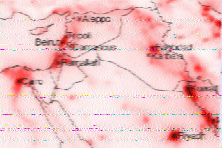
This is VOA Radiogram from the Voice of America.
Please send reception reports to radiogram@voanews.com.
VOA NEWS
Study: Diminished Marine Biodiversity Threatens Food Supply
Rosanne Skirble
August 25, 2015
Warming oceans will cause profound changes in the biodiversity of
marine life, according to the largest study ever of marine
species. Some species will expand into new regions, while others,
especially in the tropics and reef areas, will likely die out.
An international research team used a model that looked at sea
surface temperature changes and then compared that information
with data on heat tolerance of individual species and habitat
preference. The findings describe the distribution for nearly
13,000 species worldwide.
Tropics hardest hit
The tropics will be hardest hit with species extinction because
they are less likely to adapt. "This is especially worrying and
highly germane to Australia's coral reefs," said the report's
co-author, Professor John Pandolfi of the ARC Centre of
Excellence for Coral Reef Studies at Australia's University of
Queensland. "Complementary studies have shown high levels of
extinction risk in tropical biotas [local marine ecosystems]
where localized human impacts as well as climate change have
resulted in substantial degradation."
Although other species will move about more easily, Pandolfi says
that, too, has a down side. "Instead of having discrete
differentiation of different marine communities in different
places, we found in our analysis that projected climate change is
going to result in a lot more mixing of species and a lot more
sameness of diversity throughout the world's oceans."
Loss of biodiversity, loss of food
The study charts these changes out to the year 2100. That
sameness in the ocean is especially problematic as new strategies
are put into place to meet the food demands of a growing
population.
"When one formally abundant species moves into a new ecosystem or
geographic region they not be able to reproduce as effectively as
they used to," Pandolfi said. "It comes down to understanding the
dynamism that is going to be imposed from climate change and
being able to have the tools to manage for those dynamics."
Unless global emissions are controlled, the planet and its oceans
will continue to heat up, unleashing a series of impacts as
predicted by the study. New combinations of resident and invader
species will present unprecedented challenges for conservation
planning.
"That's something I think that it isn't easy for people to get
their heads around," Pandolfi said. "Now if I'm going to set up a
marine park, I want to make sure that organisms are preserved
through decades or centuries. With climate change, those
communities are going to be dynamic. They are not going to be
static entities."
In the warmer ocean, species will cross into new geographic areas
beyond political boundaries. Pandolfi says the study, published
in Nature Climate Change, underscores the importance of
cooperation among nations to address climate change and the
potential loss of biodiversity.
http://www.voanews.com/content/nature-climate-change-marine-biodiversity-study-food/2932049.html
See also:
http://www.coralcoe.org.au/
Image: Screen capture from ABC (Australia) report on the Great
Barrier Reef ...
Sending Pic:252x129C;
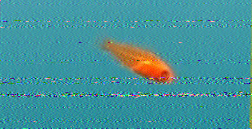
Image from:
http://www.abc.net.au/catalyst/stories/4132834.htm
This is VOA Radiogram from the Voice of America.
Please send reception reports to radiogram@voanews.com.
VOA NEWS
Researchers Map Plastic Debris in Pacific Ocean
Rick Pantaleo
VOA Science World Blog
August 24th, 2015
A team of volunteers, sailing in a flotilla of some thirty
vessels, has successfully completed its month long research
expedition through the western portion of the infamous Great
Pacific Ocean Garbage Patch.
The first group of boats from the 30 vessel fleet, along with the
Ocean Starr, a former NOAA research vehicle which served as the
expedition's "mother ship", ended their journey when they sailed
into in the port of San Francisco on Sunday, 8/23/15.
The Dutch environmental organization founded by Boylan Slat,
called the Ocean Cleanup conducted its Mega Expedition
Reconnaissance Mission through the massive collection of marine
debris so that it could gather data to find out how much plastic
is actually floating in the Pacific Ocean.
Nearly 8 million tons of plastic, mostly from land enters the
ocean every year said a recent study.
Researchers say that portions of this huge collection of plastic,
along with other forms of marine debris, gathers in five areas of
the world's oceans where the currents meet called the gyres.
A 2014 study found that currently there are at least 5.25
trillion pieces of plastic floating in the oceans with about
third of it concentrated in the Great Pacific Garbage Patch.
The impacts of plastic pollution include harm to the environment,
economy and human health.
About one million seabirds and one-hundred thousand marine
mammals die every year due to plastic pollution, according to a
1997 study.
Toxic chemicals that are found in and can be amplified by the
plastic pollutants enter the human daily diet through fish and
other edible sea creatures who consume plastic polluted food.
Health effects that have been tied to these food borne chemicals
include cancer, birth defects, immune system problems, and
childhood developmental issues.
The Ocean Cleanup group plans to use the gathered data to create
the first high-resolution map of plastic in the Pacific as well
as to help in the preparation for the organization's large scale
ocean cleanup project that's planned for 2020.
The thirty vessels sailed in parallel with each other over a 3.6
million square kilometer course in the Pacific Ocean. Over the
month long period, the boats made around fifty crossings between
the U.S. West Coast and Hawaii to conduct surveys on the amount
of plastic they came across.
The expedition used a variety of measurement techniques to gather
data. Each of the boats towed a trawling net so that they could
sample some of the smaller debris floating in the ocean. They
tallied the larger pieces of debris with a special smart phone
application called "The Ocean Cleanup survey app."
To study large objects like ghost nets – fishing nets lost or
left in the ocean – and debris from the 2011 Japanese Tsunami,
the researchers also used an aerial camera system and giant nets
that were aboard the Ocean Starr mothership.
According to a report from the Associated Press, most of the
trash found by the expedition, including a one ton fishing net,
were in medium to large pieces.
http://blogs.voanews.com/science-world/2015/08/24/researchers-map-plastic-debris-in-pacific-ocean/
See also:
http://oceanservice.noaa.gov/facts/garbagepatch.html
Image: Map showing one of the concentrations of debris in the
Pacific Ocean.
Sending Pic:249x147C;
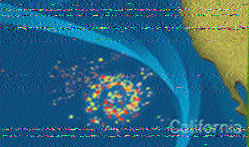
This is VOA Radiogram from the Voice of America.
Please send reception reports to radiogram@voanews.com.
Mark Hirst in the UK observes that much of the noise that causes
interference to MFSK images occures in the lower audio
frequencies.
Can we reduce interference by moving to a higher audio frequency?
We will now transmit the previous image in MFSK32 but at a center
audio frequency of 2000 Hz ...
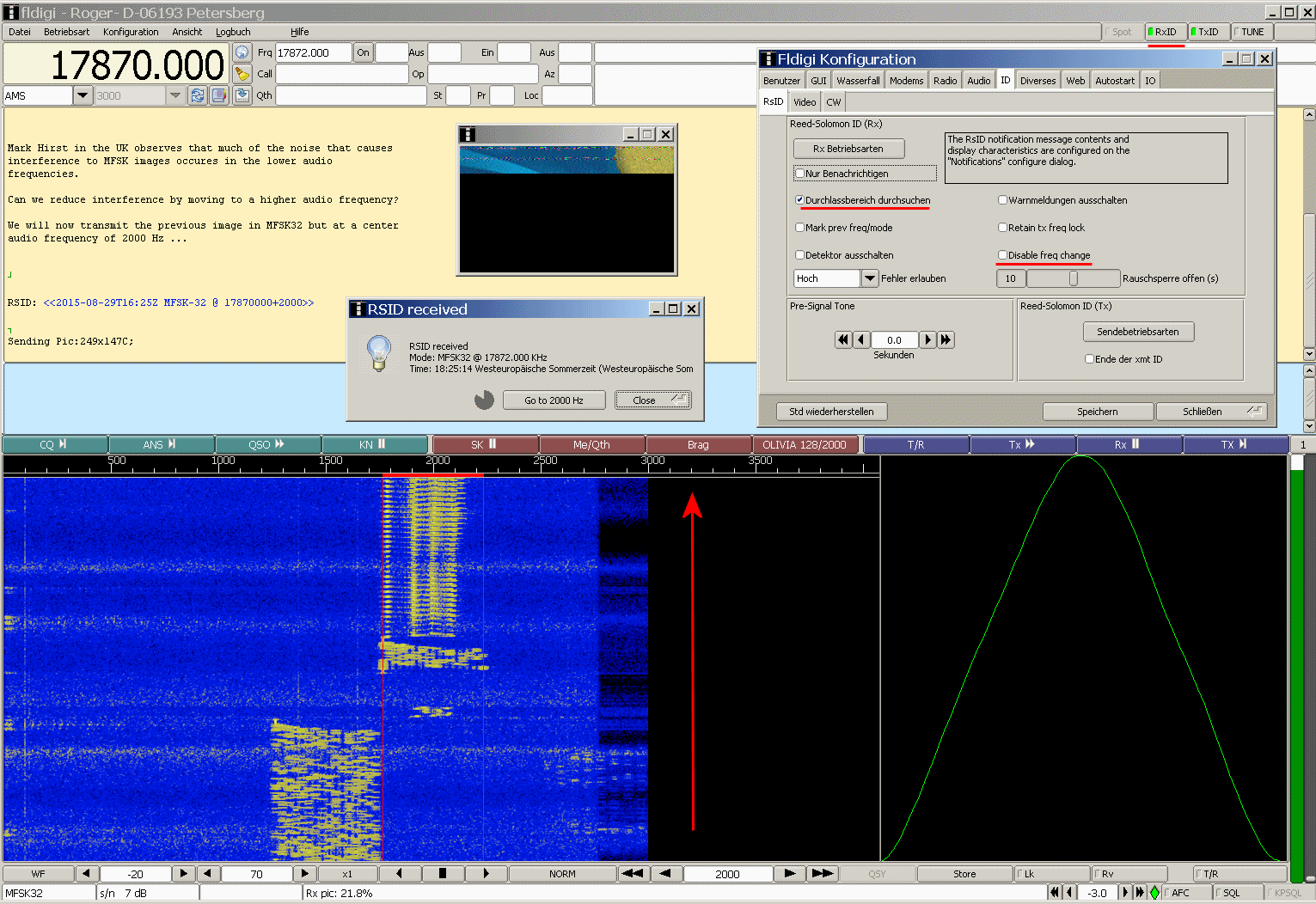
RSID: <<2015-08-29T16:25Z
MFSK-32 @ 17870000+2000>>
|
Sending Pic:249x147C
|
MFSK-32 @ 1500 Hz
|
MFSK-32 @ 2000 Hz
|
|
|
|
|
|
The location of the MFSK-mode in the AF area does not have any significant influence on the quality of the images. The horizontal noise stripes originate from instantaneous fading dips and this affect the entire decoded audio-range. If higher AF-frequencies are used, the risk of QRM influences from adjacent channels maybe increases,
when demodulation in pure AM. |
||
VOA returns to our usual center audio frequency of 1500 Hz,
MFSK32 ...
RSID: <<2015-08-29T16:26Z
MFSK-32 @ 17870000+1500>>
Please send reception reports to radiogram@voanews.com.
And visit voaradiogram.net.
Twitter: @VOARadiogram
Thanks to colleagues at the Edward R. Murrow shortwave
transmitting station in North Carolina.
I'm Kim Elliott. Please join us for the next VOA Radiogram.
This is VOA, the Voice of America.
Sending Pic:316x28C;
![]()
RSID: <<2015-08-29T16:28Z
OL 64-2K @ 17870000+1500>>
VOA Radiogram transmission schedule
(days/times UTC):
Sat 0930-1000 5745 kHz
Sat 1600-1630 17870 kHz
Sun 0230-0300 5745 kHz
Sun 1930-2000 15670 kHz
All via North Carolina
www.rhci-online.net/radiogram/radiogram.htm
|
QTH: |
D-06193 Petersberg (Germany/Germania) |
|
|
Ant.: |
Dipol for 40m-Band & Boomerang Antenna 11m-Band |
|
|
RX for RF: |
FRG-100B + IF-mixer & ICOM IC-R75 + IF-mixer |
|
|
Software IF: |
con STUDIO1 - Software italiano per SDR [S-AM-USB/LSB] |
|
|
Software AF: |
||
|
OS: |
German XP-SP3 with support for asian languages |
German W7 32bit + 64bit |
|
PC: |
MEDION Titanium 8008 (since 2003) [ P4 - 2,6 GHz] |
MSI-CR70-2MP345W7 (since2014) [i5 -P3560 ( 2 x 2,6GHz) ] |
DRM-images - received via EASYPAL/DSSTV on 14233kHz/USB (FRG-100 / Dipol for ~12 MHz)
Here are some pics of EA1FA [Fernando F.A. (Fernandez Amorim), Plaza de la madera 3-3ºA, 33610 Turón / Mieres, Comunidad Autónoma de Asturias / España] received in the last time:
|
|
|
|
|
|
|
|
|
|
|
|
|
|
|
|
|
|
|
|
|
|
|
|
|
|
|
|
|
|
|
|
|
|
|
|
|
|
|
|
|
|
|
|
|
|
|
|
|
|
|
|
|
|
|
|
|
|
|
|
|
|
|
|
|
|
|
|
|
|
|
|
|
|
|
|
|
|
|
|
|
|
|
|
|
|
|
|
|
|
|
|
|
|
|
|
|
|
|
|
|
|
|
|